COMPASS THE
SPRING 2025

STUDY SKILLS PROGRAM LAYS FOUNDATIONS BRICK BY BRICK




STUDY SKILLS PROGRAM LAYS FOUNDATIONS BRICK BY BRICK


The Compass is published twice a year by the School's marketing and communications office. It is a magazine for The Windward School community.
Jamie Williamson
Head of School
JP Bifone
Director of Marketing and Communications
Jana Cook
Editor and Associate Director of Marketing and Communications
Contributing Editorial Staff:
JP Bifone, Timothy Brosnan, Hope Geise, Lucy Godman, and Nicole Nearchou
Contributing Writers:
Timothy Brosnan, Jana Cook, Dina DiGiacomo, Shirley Hwang, Kayla Morales, Nicole Nearchou, Danielle Ngo, Mackenzie Skerritt, and Jamie Williamson
Contributing Photographers:
Timothy Brosnan, Mark Liflander, Joe Martin, Siobhan Mullan, Susan Nagib, and Nicole Nearchou
Design: hgDesign, NYC
BOARD OF TRUSTEES 2024-2025
Maria Reed, President
Jenny Price, 1st Vice President
Peter A. D’Avanzo, 2nd Vice President
David Friedland, Treasurer
Staci Marlowe, Secretary
Denis J. O’Leary, III ’06, Member-at-Large
Patricia L. Wolff, Member-at-Large
Akeela Azcuy, PhD
Margi Booth
Reed Brodsky
Thomas J. Coleman
Michael Cummins
Beth Demba
Chris Dooley
Meredith Jenkins
Mitchell J. Katz
Ian Levine
Magdalena Zavalía Miguens
Kenneth Squire
Reed Switzer ’19
Nicholas Van Amburg
Jennifer Weyburn
The Windward School does not discriminate in admissions, employment, or administration of programs on the basis of gender, race, religion, age, national or ethnic origin, or sexual orientation.
Note: At The Windward School, a student's class year is the same as their high school graduation year.

Windward maintains a disciplined and rigorous approach to all we do, and our every action is guided by an unparalleled commitment to a world where every child with a language-based learning disability is empowered to achieve unlimited success.
I knew when I joined The Windward School that it would be a career highlight, because the evidence base for all the School’s programs is so incredibly solid. As a data-driven thinker, I have always gravitated toward what has been proven to work. And what does work to effectively remediate the challenges that students with language-based learning disabilities face is a research-based program delivered with fidelity and integrity. The meticulous care that Windward takes with every instructional decision, following the research where it leads and then translating it effectively into classroom practice, reveals its deep commitment to its students. This commitment is what drew me to this school, and it is what inspires me to protect the foundation of the program and continue to explore ways in which we can even better prepare our students for long-term success.
One of many Windward programs that has stood the test of time—and that alumni consistently refer to as being instrumental to their academic journeys later—is Study Skills, spotlighted in this issue’s feature article. Learn how the program systematically teaches students all the steps of preparing a research paper and presenting it to peers, an essential skill for both high school and university courses.
Well before students encounter their first research paper, they are learning about reliable sources and how to grow their knowledge on a topic through the School’s library curriculum, another focus of this issue. And of course a foundation of Windward’s mission is to successfully transition students into mainstream settings when they are ready; the outplacement department diligently guides students through the decision-making process, working closely with families to find an ideal fit.
As we look toward the future, we remain steadfast in our commitment to the most current evidence-based practices, as we both expand and enhance existing programs based on emerging research. Adopting the RULER Approach to bolster Windward’s social-emotional learning (SEL) program is one example. The first in a series of four SEL articles about the RULER program examines one simple, effective tool: The Mood Meter.
These are just some of the pieces reflecting this issue’s theme, Windward’s core value of commitment. I feel so much gratitude for this entire community as partners in this work, as we collectively aim for a future where every child with a language-based learning disability is empowered to achieve unlimited success.


After a yearlong, extensive planning process, the School was thrilled to launch its aftercare program for lower school students beginning in the 2024-2025 academic year. The program offers Windward families flexibility for student pickup in the afternoon, providing care from dismissal at 3:00 p.m. until 5:30 p.m., Monday through Thursday. Students participating in after-school clubs and activities also have the opportunity to transition to aftercare at 4:30 p.m.
Families can select from a variety of options for enrolling in the program. Some families may choose to have their child attend regularly, while others use the program for temporary aftercare needs. Registration is also available on an ad-hoc basis, provided that families notify the school by 11 a.m. on the day aftercare is required, for program directors to plan appropriately.
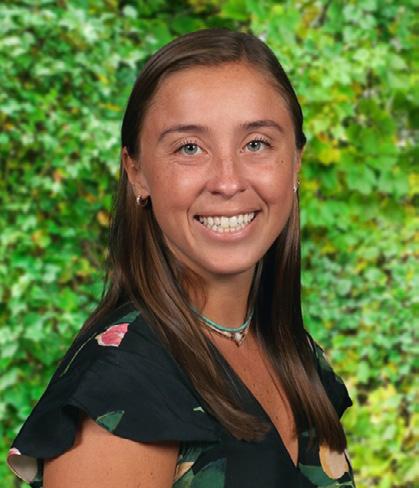
During aftercare, students enjoy a light snack provided by the School and are encouraged to use the time as they choose, whether it’s connecting with peers through group play, taking part in quiet activities such as drawing, or completing homework. Associate Head of School Jonathan Rosenshine explains, “Students have a long, structured school day, and this program is about giving kids time to be together, to play, to rest, or to get started on their homework.”
Program directors include Andrea Tolliver at Westchester Lower School and Jamie Carroll and Jamie Simon at Manhattan Lower School.
“One fourth grader shared that their favorite part of aftercare is getting to play with kids from other grades. Students who may not have met otherwise are forming new friendships, and the program has become a meaningful way to build community across our lower school.”
— Jamie Carroll
“Sometimes families utilize aftercare to organize on-campus playdates, helping facilitate friendships that otherwise might be challenging due to distance or scheduling conflicts. For students working on homework during this time, having adult support has been such an asset for families with long commutes or those who work late hours.”
—
Andrea Tolliver


“The pilot program for aftercare this year has been a success! In fact, many fifth graders have already inquired about opening up the program to sixth graders. They have enjoyed it so much they hope to come back again!”
— Jamie Simon
In 2011, Windward articulated its ambitious goal for expanding access to the School’s program with the Windward 2020: Share the Vision capital campaign. At that time, increasingly long wait lists necessitated that Windward broaden its capacity to serve more students.
To make this vision a reality, the first priority was expanding the Windward Teacher Training Program (WTTP), in order to hire and train additional staff with the pedagogical training they needed to effectively teach the Windward curriculum. The contributions of many generous donors supported the construction of designated teacher training facilities at Westchester Middle School, as well as a new Manhattan campus on the Upper East Side.
Ten years ago this year, Windward’s Manhattan Lower and Middle Schools campus opened its doors to 107 students in its temporary facility at 97th Street and
Amsterdam Avenue. One year later, the School’s permanent 60,000-square-foot New York City location at 212 East 93rd Street welcomed 205 students in grades 2 through 7.
This massive achievement doubled the number of seats the School could offer to students, providing many more families the benefit of a transformative Windward education. The 2025-2026 school year marks the tenth anniversary of opening a campus in Manhattan, and there is much to celebrate. A 10-year anniversary committee has been hard at work planning ways in which the community can recognize this milestone in style, with events, programs, and fanfare. Stay tuned for more information in the fall.

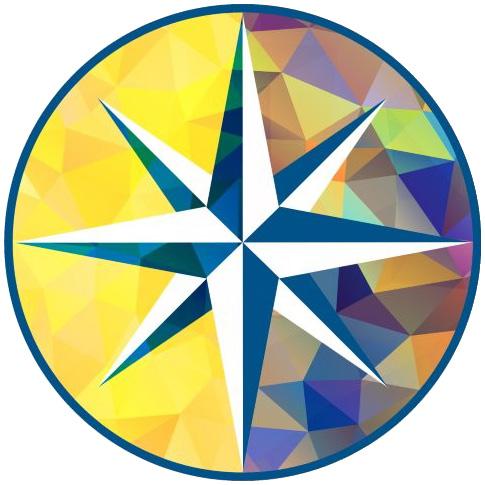

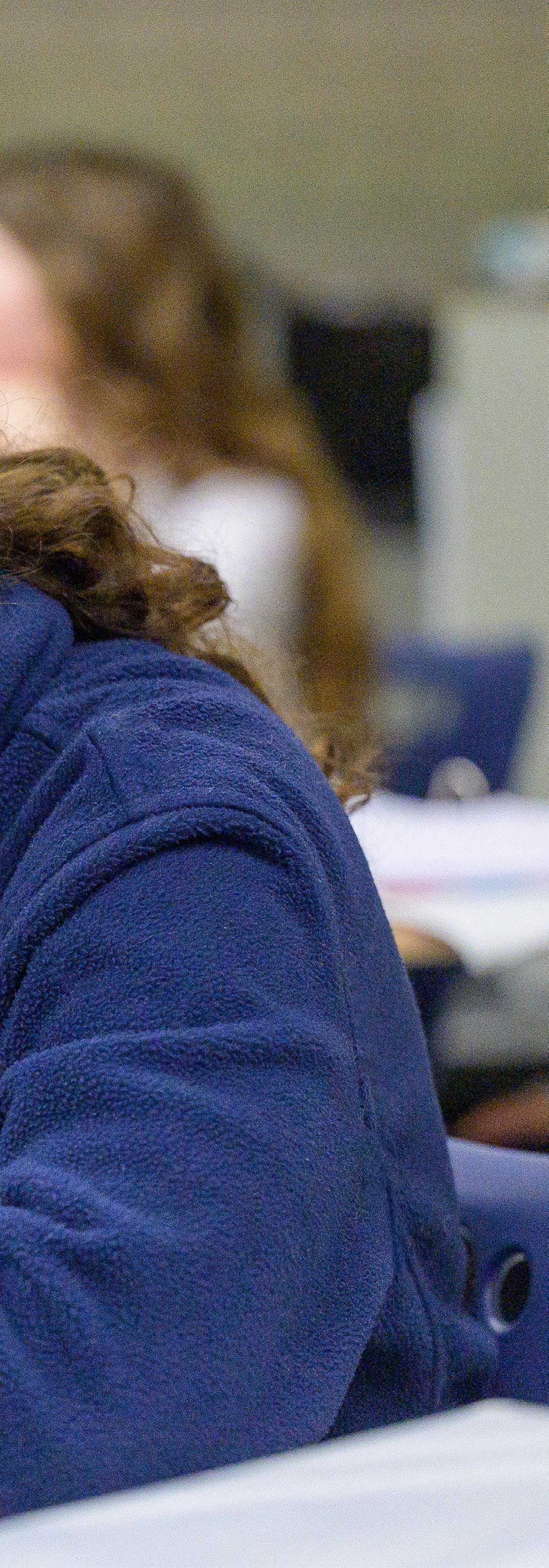
There is a myth that skilled writers are born with that talent. Some people may picture a blossoming author sitting in front of a screen, where beautifully crafted sentences and paragraphs emerge fully realized, seemingly gifted to the page. The truth is that writers are made, not born. And one of the most useful skills educators can teach students is how to write fluidly, clearly, and concisely. Still, it is not uncommon for people to remember their first research paper as an assignment essentially being thrown at them, with minimal guidelines or instruction on how to write it.
A critical piece of Windward’s mission is preparing its students for the transition to mainstream schools. Giving them the tools to succeed academically not only eases this transition but also instills confidence in our students as they venture into new educational settings. To support this goal, the School established a capstone program for eighth and ninth graders: Study Skills, a sequential curriculum that systematically instructs students in all the skills needed for preparing a research paper and, later, presenting the project to a group of peers.
Almost without fail, those Windward alumni who stayed at the School through the eighth grade note Study Skills as being particularly impactful on their journeys through high school, college, and, in some cases, their careers. What is enduringly special about this program that alumni point to it, sometimes decades later, as being a formative experience? As it turns out, quite a bit.
Years before students sit in their first Study Skills class, they are gradually, methodically laying a foundation for understanding the formal writing process. As one of three dedicated language arts periods per day, Windward’s expository writing program teaches students to express themselves in written form through explicit instruction in writing sentences, paragraphs, and compositions. Structured writing time—like all the School’s programs—is designed to provide the most robust supports in the beginning, followed by reinforcement, review, and the gradual release of responsibility to the student.
Starting in the earliest elementary grades, students begin learning how to write at the sentence level.

Starting in the earliest elementary grades, students begin learning how to write at the sentence level. As soon as the first grade, students generate oral paragraphs as a class, while second grade classes progress to writing teacher-guided paragraphs. Third graders continue practicing paragraph-writing activities, which progress to two-paragraph essays by fourth grade. Teachers present students with the Advanced Composition Outline planning tool in fifth grade; students then tackle their first five-paragraph composition with an introduction, body, and conclusion. In sixth and seventh grades, the assignments are stretched little by little, and students become accustomed to writing essays with several body paragraphs.
In structuring the content itself, students are in no way left to navigate this process alone. They learn about the concept of the inverted triangle—or

a blueprint for organizing the introduction to an essay—that first presents a broad overview of the topic, followed by narrowing statements highlighting the body paragraphs’ focus, and, finally, a thesis statement that outlines the main argument or purpose. The triangle is flipped for the conclusion: first a restatement of the thesis, then statements summarizing the body of the essay, and, lastly, a general statement on the topic.
Providing students with a deeply structured approach to writing gives students the scaffold they need to build their skills. Former Director of Language Arts and current Special Projects Advisor to The Windward Institute Betsy MacDermott-Duffy notes, “We always compare it to a recipe. You can get creative after you’ve got the basics down, but you have to start with the basics.”
See this example introduction for a multi-paragraph essay on Eleanor Roosevelt:


Constructing the framework that culminates in the Study Skills program begins in the lower schools, as students begin learning about the elements of print. Coordinator of Study Skills and Westchester Middle School Teacher Tim Caccopola explains, “We prime the students with early work in looking at the basic features of books: identifying the title, the table of contents, and the index. They’ll use the table of contents and the index to locate little subheadings and subsections and then use those keywords to locate more information separate from just the general topic. For example, on the Triangle Shirtwaist Factory fire, we know a subsection was on sweatshops and working conditions. We’ll go to the index and see if we can locate that information.”
Through their language arts, social studies, and library coursework, students build knowledge about reliable research sources, close reading, notetaking, summarizing, and outlining. They begin to hone their presentation skills in the fourth and fifth grades, as they learn about creating a slide deck in PowerPoint for reporting out to the class on a given topic. In middle school, students frequently participate in read-alouds, an exercise that allows them to practice reading with expression, projecting their voices, and pacing appropriately so that their audience remains engaged.
Study skills groupings—like all language arts classes —are homogeneous. Arranging cohorts in this way allows Study Skills teachers to offer supports aligned with student need at each stage of the process. For example, some groups may require more support for a longer period of time, while other groups may more quickly shift to independent work. Associate Director of Language Arts Colleen McGlynn says, “Having the kids grouped with their language arts group makes it much easier to be able to differentiate the level of independence.” At all levels, because students are generating one research paper each quarter, they continue to refine their research, writing, presentation, and time management skills as the year progresses.
Arranging cohorts [homogeneously] allows Study Skills teachers to offer supports aligned with student need at each stage of the process.
Approaching a multi-page research paper can at first feel overwhelming for many students, especially those with challenges around executive function. In order to break down this larger task into manageable chunks, creating a solid Research Plan becomes invaluable in guiding a writer’s efforts. This document—meant as a quick reference that a student can return to throughout the process—opens with the working thesis, followed by divisions for each section, naming their topics; each section is then divided into subsections, outlining the main ideas to be covered by the body paragraphs. Students can follow this guideline step by step as they progress through the assignment, ensuring that content remains on track.
Though deceptively barebones at first glance, the Research Plan has proven such a useful tool for students that returning alumni often seek out Caccopola to share, “I still make a research plan to map out my projects at the beginning!”
Take a look at this simple, effective example of a Research Plan for an essay on Eleanor Roosevelt:


Note that each section has a title describing its focus, with subsection topics clearly divided into content areas. If a student is tempted to veer off on a tangent at any point, they can refer to the Research Plan as a reminder of the main points supporting their thesis.
If the Research Plan acts as a framework for approaching the project, the Advanced Composition Outline functions as an instruction manual for building each piece of the essay’s structure. Typically, Windward students are introduced to this planning tool in fifth grade, so they have had years of experience using it to inform their writing processes by the time they begin Study Skills.
Notice how this portion of the outline fleshes out section 3 from the Research Plan previously shown, outlining the details to cover under each subsection of the main section.

As students immerse themselves in the research process, they synthesize information from multiple sources using a system of note cards, which they group together by main section and additionally by subsection. Caccopola notes, “This multisensory element is one strategy that supports students’ executive functioning. Building up their notes and source citations on these tangible cards helps keep all their information organized sequentially and chronologically.” Prior to creating the Advanced Composition Outline, students can easily rearrange note cards into an order that makes sense; then they can capture this information in bullet points on the outline, which maps out the content progression and is students’ guideline as they draft their essays.
One differentiator of the Study Skills program is the ongoing feedback students receive throughout the writing process. In many schools, students are assigned a research paper, complete it independently, and submit it in its entirety for grading. The problem with this approach is that if a student is consistently making similar grammatical errors or using awkward syntax, for example, these errors will reappear throughout the paper. Making corrections as they write not only eliminates repetitive mistakes, but it also gives students real-time context, aiding in retention of the information.
One differentiator of the Study Skills program is the ongoing feedback students receive throughout the writing process.
Consistent feedback from teachers is also critical due to the technical nature of formal writing, as regular input on their progress helps build students’ confidence in this area. “For example, we’ll collect just the introduction and give feedback on that. We’ll collect just section one and give feedback on that. Then we’ll look at section one and two and give feedback. There are multiple steps to drafting,” Caccopola notes.
MacDermott-Duffy shares, “As another example, a Windward student isn’t creating a thesis—the statement that drives the whole paper—without input from the teacher. If the statement is too narrow, it won’t support an entire five- or six-page research paper; if the statement is too broad, it is equally difficult to support. Getting that teacher feedback at every stage of the process is so important.”
To cap off the project, students create a PowerPoint presentation distilling the multitude of information in the research paper into a briefer, visual format, which each student then delivers to their class.
Typically introduced during the second semester of Study Skills, after students have already tackled one to two research papers, the PowerPoint aspect of the project is noted as a highlight of the program by teachers and Windward families. Caccopola shares, “Parents and guardians really appreciate the instruction and the modeling on PowerPoint presentations, having students be able to present on their topics for 8 to 10 minutes and then be assessed on the visual aspects, the aesthetics, the content, and the delivery of their presentation.”
Developing strong expressive language is a powerful tool students can take with them to their next schools or even, eventually, to their careers.
“Getting in front of their peers and presenting on topics, informing their audience: There are so many layers. There are so many life skills there,” Caccopola continues. Effective oral communication is particularly important for higher education and the workforce, so honing and enhancing those skills proves incredibly valuable in the long term.
“Students become aware of their writing and what good writers do. It’s not just about the content of what they’re writing. They’re also thinking about how they’re writing it.”
— Colleen McGlynn
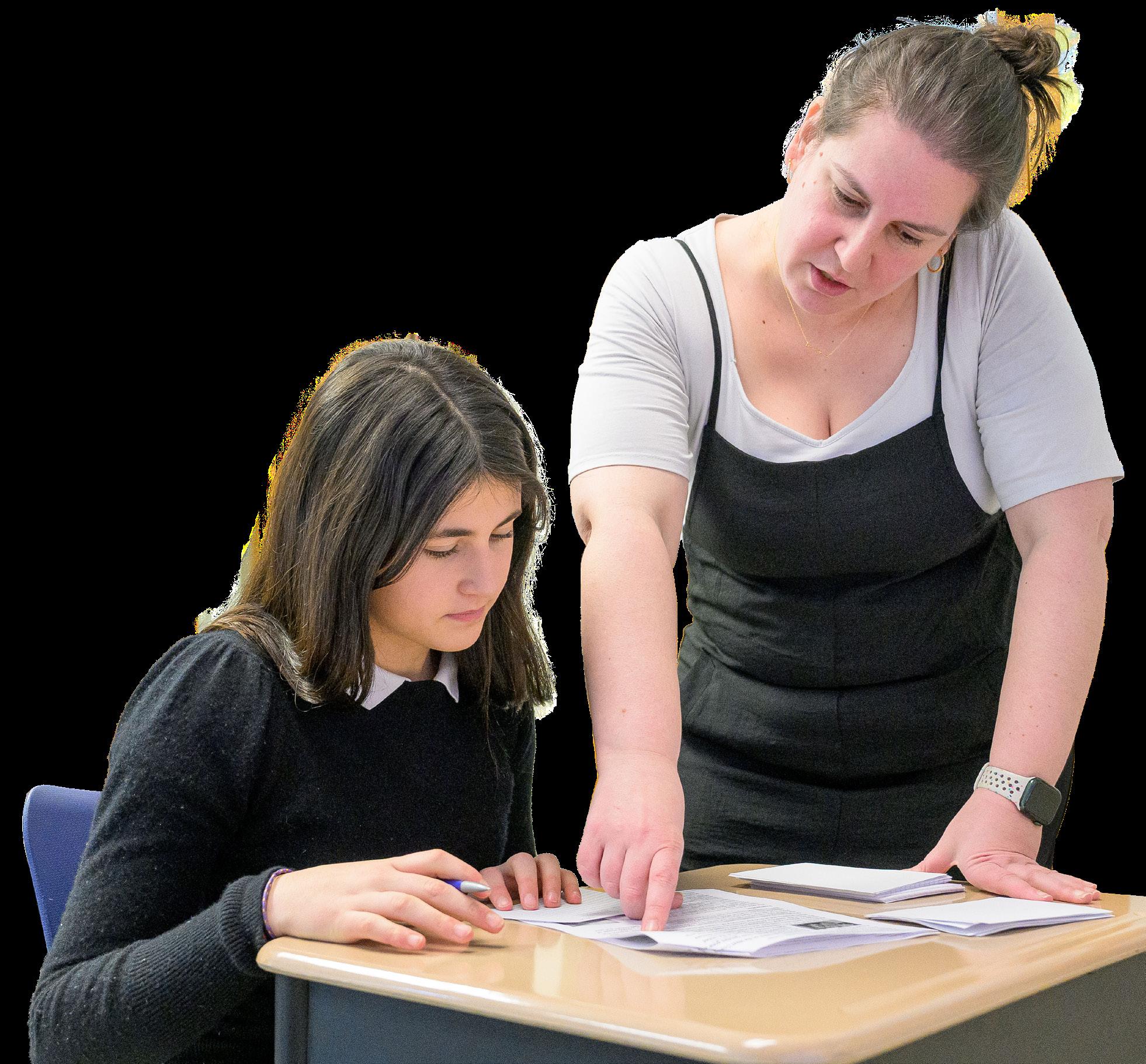
It’s impossible to overstate the profound impact that the Study Skills program has had on Windward students. It is not just that students learn how to craft a piece of formal writing, though that is an important skill, which will serve them well; it is that they begin to understand how to approach the process as a whole. MacDermott-Duffy notes, “While refining the program years ago, what emerged was the importance of drafting a Research Plan. If the end product is not successful, that shows there is something wrong with the plan. So, we ensure from the beginning that elements ranging from topic, purpose, and audience to outlining the draft to narrowing the thesis statement are all pointed toward the quality of the final product.”
And not only are students being explicitly taught—over a span of years—how to research a topic, utilize source materials, and write coherently and independently, but they are also gaining insights into what differentiates good compositions from weaker pieces. Through the systematic exploration of the writing process, McGlynn explains, “Students become aware of their writing and what good writers do. It’s not just about the content of what they’re writing. They’re also thinking about how they’re writing it.”
When students have received cumulative instruction in effective writing, from lower school onward, tackling a momentous project like a research paper feels less daunting. They have already accumulated the skills they will call upon
to complete the project; it then becomes a matter of flexing those skills with the support and guidance of a dedicated teacher.
Students gain crucial experience in time management, as well, as they use their Research Plan to divide the larger project into smaller tasks, setting deadlines for themselves along the way. “They have a calendar where they keep track of when each step is due, and I think that’s really helpful. That’s absolutely a skill that the kids could take with them for life,” adds McGlynn. Indeed, many alumni have echoed that sentiment. One alumna profiled recently in The Compass, who now works at the federal level drafting public policy, shares, “The Study Skills program truly built the foundation for how I [approach writing], even today.”
For many Windward students who struggle with executive functioning, completing a massive assignment like a multi-page research paper can be incredibly taxing on the brain, even with an organizational framework laid out for them. This is due to the limited capacity of working memory, which is a part of the brain’s executive function that temporarily holds and manipulates information. Accumulating knowledge about a subject over time and in multiple contexts eases that burden. Students gradually build background knowledge as they encounter material, making connections across subject areas. For example, students may be assigned to write about Andrew Carnegie in Study Skills; at the same time, they are learning about the gilded age and the robber barons in their social
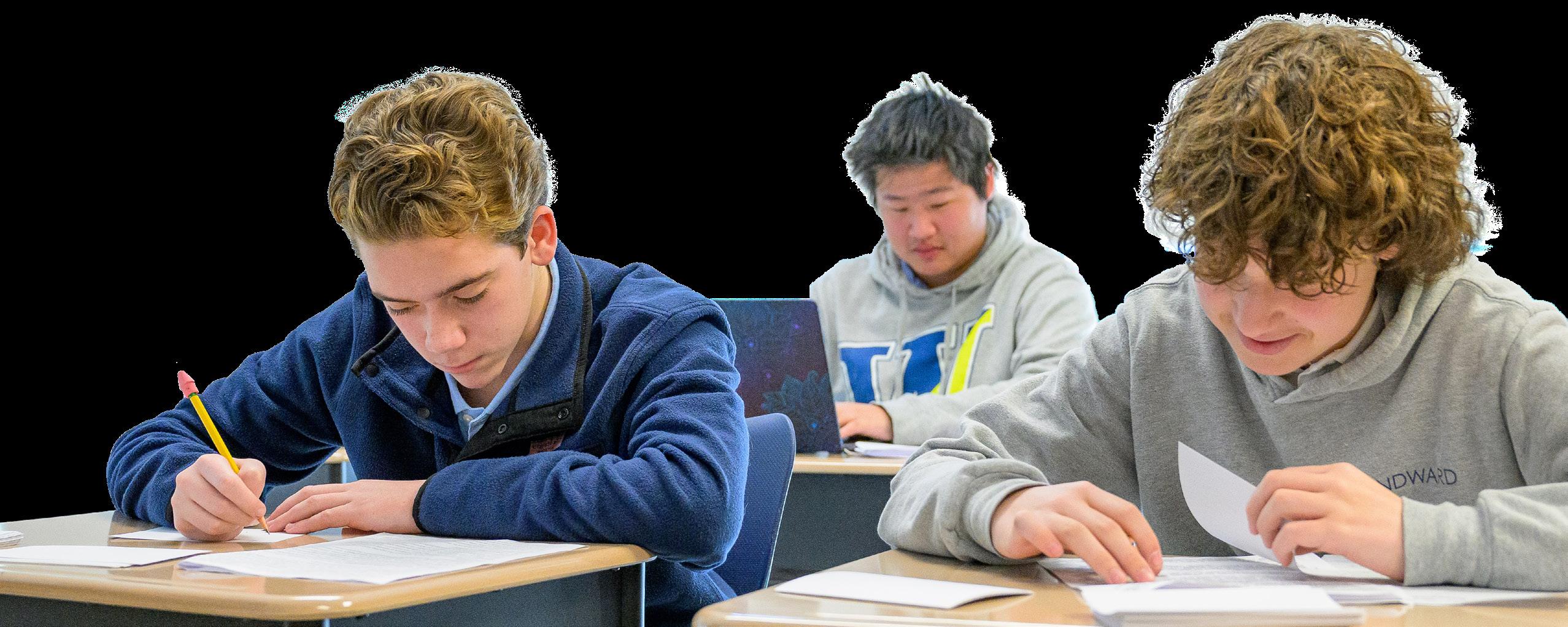

studies classes. McGlynn explains, “So they’re able to use their knowledge from social studies to help them access some of this material in Study Skills, and then Study Skills is really building this wealth of knowledge. They’re reading at least four, maybe five articles about Carnegie, or about the historical time period, to deepen that understanding before even getting to write the paper.”
emerged in recent research as an important piece of reading comprehension.

Knowledge building, or cultivating deep knowledge in students through curriculum that supports that concept, has emerged in recent research as an important piece of reading comprehension. Windward has embraced this approach for years, and the Study Skills program is a clear reflection of that. Associate Head of School for Academic Programs Lisa Murray notes, “Because the research is so solid on knowledge building aiding reading comprehension, we’re constantly looking for ways to build knowledge even more for our kids while they’re at Windward. And I think Study Skills really speaks to that because it’s a whole yearlong exercise. Each of the projects is building that deeper knowledge, connecting to other content areas, mainly history, but other areas as well, like science. It makes our academic program such a standout.”

As the program has evolved, its coordinators have worked toward making it more inclusive, from adding more projects focused on different cultures to including more uses of assistive technology. “For those kids that struggle with handwriting and legibility, the note card process can be prohibitively labor intensive. We’ve started to adopt more assistive technology, with digital note cards and editable documents that students can work through online,” shares Caccopola.
In collaboration with Director of Educational Technology Joan McGettigan, Study Skills coordinators and teachers also use various tools within Microsoft Teams to help students form effective queries, evaluate their sources, and obtain real-time feedback on presentation skills. Adds Caccopola, “Teams, which we use more widely as a program to help students with time management and tracking assignments, also offers Learning Accelerators: Search Coach—a simple app that assists students in forming effective queries and identifying reliable resources— and Presenter Coach.” Presenter Coach allows students to record their presentations and receive instant feedback on voice intonation, tone inflection, modulation, gesturing, and use of filler words. The program then shares percentages for areas that need improvement.
As the culmination of years of foundational work in reading comprehension, notetaking, outlining, and writing, Study Skills offers Windward students a unique toolkit that is both unmatched and incredibly useful—wherever their journeys take them. This toolkit’s purpose is not limited to its practical application, as it also empowers students to approach future writing assignments with confidence, secure in the knowledge that they are prepared. Alumni often note that they turn to elements of the program—such as how to effectively manage their time, how to balance and track deadlines, and how to drive a project using a research plan—to inform any number of tasks related to their academic journeys and, later, their careers. It is rare that a single course has such a lasting effect. And while all Windward programs are guided by the commitment to empower students to achieve unlimited success, few are more illustrative of this disciplined approach than Study Skills. At any alumni event, simply ask an alum, “Which Windward program had the biggest impact on


The outplacement department at The Windward School plays a critical role in ensuring that students transition successfully into mainstream schools when they are ready. Led by Diane Kissner, the department takes a deeply personalized and family-centered approach to guiding students and their families through the outplacement process. With a strong emphasis on readiness, selfadvocacy, and the invaluable benefits of Windward’s Study Skills program, Kissner and her team are committed to setting up students for long-term success.
For many families, the outplacement process begins in the spring of their child’s seventh-grade year. Students are typically planning for their transition after eighth grade at this stage, and the department provides them with essential guidance and structure. A crucial first step is an outplacement information session, which helps families understand the process and what to expect. Following this, each family meets individually with the department to discuss potential school choices and the student’s academic needs.
While school selection is an important aspect, Kissner emphasizes that the process goes far beyond simply matching students with schools. “We know schools. And parents know their child better than anyone,” she explains. “When we work together, it turns out really well.” The department carefully assesses not only a student’s academic capabilities but also independence and overall readiness to succeed in a new environment. With these factors in mind, families are encouraged to diversify their applications to schools so that each student has at least one strong placement.
While school selection is an important aspect, Kissner emphasizes that the process goes far beyond simply matching students with schools.
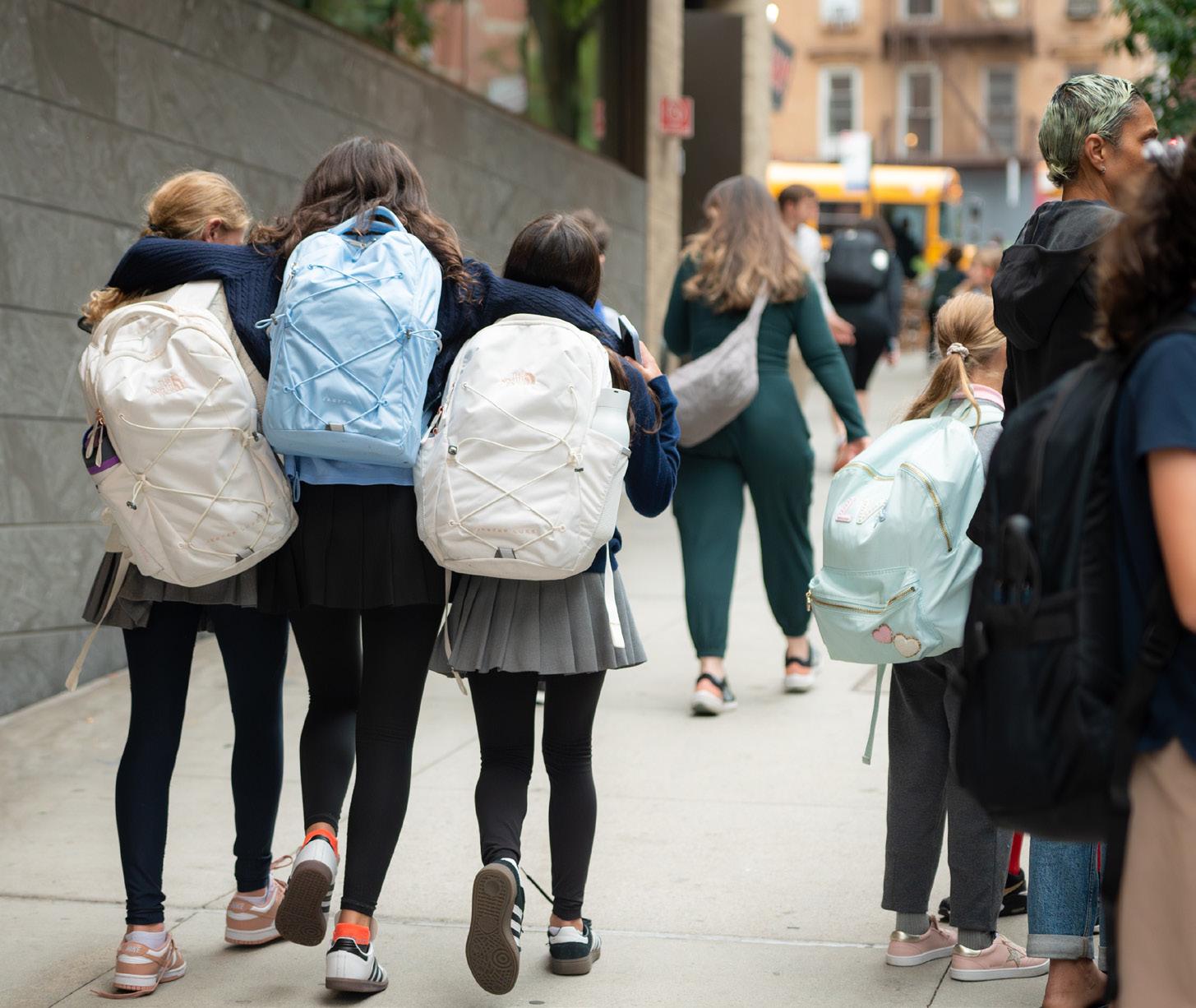
The department encourages students to take initiative in the application process, from writing personal statements to preparing for interviews.
One of the key points Kissner stresses to families is the tremendous value of staying at Windward through eighth grade. That academic year at Windward marks a significant shift for students, where they are expected to take greater ownership of their learning and practice self-advocacy. “We want to see them start to use these tools a little bit more independently,” she explains. “There’s a stronger emphasis on self-reliance in eighth grade, and we really want the kids to step up and take care of themselves.”
A highlight of the year is Windward’s Study Skills program, a highly structured course that provides students with the research and writing tools they need for high school and beyond. Over the course of the year, students learn to analyze texts, take structured notes using keywords and phrases, and synthesize information from multiple sources into a well-organized research essay.
Beyond academic preparation, the outplacement experience fosters a sense of confidence in students. They leave Windward both with strong academic skills and the self-assurance needed to navigate new surroundings. The department encourages students to take initiative in the application process, from writing personal statements to preparing for interviews. Students gain valuable experience in presenting themselves effectively and professionally, with the ability to appropriately convey their strengths.
The department’s commitment to its students does not end once they are placed in a new school. Alumni frequently return to share their successes, seek advice, or address challenges in their new academic environments. Whether assisting a family in securing proper accommodations or providing support through unforeseen academic hurdles, the outplacement department remains a trusted resource. “Our families use us as a resource long after they’ve left,” says Kissner.

A unique aspect of Windward’s outplacement process is its whole-family approach. The department recognizes that transitioning to a new school is not just about the student; it’s also about the family unit as a whole. Families are supported just as much as students, ensuring that every step of the process— from school selection to application completion—is handled with care and collaboration. “This works best when we work as a team,” says Kissner. “We provide the options, but it’s up to the family to make the final decision.”
With its deep commitment to student success, personalized approach, and ongoing support, the outplacement department at Windward makes sure that each child leaves the school not only academically prepared but also confident and selfsufficient. As Windward continues to grow, Kissner and her team remain dedicated to fine-tuning their approach, strengthening relationships with schools, and, above all, maintaining the trust of the families they serve.
The Windward School has long been recognized for its expertise in educating students with language-based learning disabilities. However, this commitment extends beyond addressing academic needs to fostering a school environment where every student feels seen, valued, and empowered. This commitment is embodied in the School’s comprehensive approach to diversity, equity, inclusion, and belonging (DEIB).
When Windward began to name DEIB as integral to its work, many within the community questioned why we needed such initiatives at the School. The simplest answer is that as an institution already serving neurodivergent learners, Windward recognizes that valuing different ways of thinking and processing information naturally aligns with the broader principles of DEIB: that is, the belief that all individuals deserve to feel accepted, safe, and supported, regardless of their identity. Therefore, Windward’s journey into intentional DEIB work stemmed from a fundamental understanding of its mission.
For Windward, a commitment to DEIB is not a separate initiative but an integral part of the School’s educational philosophy. It means actively working to integrate DEIB into everything the School does, from curriculum development to daily routines and school culture. This involves ensuring that every student, family, educator, and staff member can actively engage with and benefit from being part of a community that sees and understands each member for who they are. The School’s DEIB commitment can be organized into four pillars: creating an inclusive curriculum, encouraging student empowerment, generating spaces that nurture ongoing dialogue about equity and inclusion, and professional development for faculty and staff. Windward employs various strategies to achieve this.
• Curriculum Integration: Coordinators, along with teachers, conduct yearly inventories of lessons to guarantee they are incorporating books featuring diverse characters and stories. The DEIB office also supports teachers in planning lessons that include discussions around topics such as race, class, culture, ability, gender, and religion through texts that bring an array of representation to reflect the experiences of a multiplicity of people from different backgrounds. This ensures students develop a deeper understanding and appreciation for different cultures and identities.
• Daily Acknowledgments: The School acknowledges various heritage months and other holidays and observances in the morning announcement slides, community meetings, bulletin boards, library displays, and special events, to raise awareness and celebrate the richness of histories and stories around the world.
• Targeted Lessons: Windward has also created lessons that focus on identity to support the healthy development of children living in a diverse community. This includes lessons that address behaviors that go against our values, such as the impact of microaggressions and stereotyping. The purpose is to establish a shared understanding that everyone belongs at Windward.
• Student Empowerment and Inclusive Spaces: Windward believes that students are vital in shaping an inclusive school culture. One of its goals is to nurture culturally engaged critical thinkers who are prepared to be responsible citizens in an increasingly diverse world. The School is dedicated to providing opportunities for students to engage in spaces that promote diversity and acceptance. Examples include the Middle School Gender and Sexuality Alliance (GSA) club, which provides a voice for LGBTQ+ students, and the Advocacy Club, which empowers students’ voices within the academic system. These clubs offer safe and affirming environments where students can connect, share experiences, and develop the confidence to advocate for themselves and others.
• Professional Development: Windward invests in ongoing training for its faculty and staff through SEED (Seeking Educational Equity and Diversity) and DEIB-focused professional development sessions integrated in the School’s new hire orientation and throughout the academic year. These trainings aim to enhance faculty and staff understanding of DEIB principles and create a supportive and inclusive classroom and work environment. The focus on professional growth helps build a community culture centered around inclusion and belonging.
• Adult Affinity Groups: The school offers affinity groups for faculty and staff based on race, sexual identity, and religious affiliations. These groups provide a supportive space for individuals to connect, share experiences, and support one another.
Overall, Windward’s structured literacy approach already recognizes and values neurodiversity. The School extends this same intentionality to cultural awareness and the inclusion of other aspects of the human experience. In creating a community where every member feels a sense of belonging, Windward recognizes that fostering diversity and promoting equity and inclusion are essential components of a truly supportive and enriching educational experience. It is this type of learning environment that empowers Windward students to achieve unlimited success. Director of DEIB Romina Pacheco shares, “We know that we still have a long road ahead of us, yet we are committed to the work, because embracing diversity and promoting equity will ultimately benefit our entire community.”
Authors: The DEIB Campus Advisors Dina DiGiacomo, Shirley Hwang, Kayla Morales, Danielle Ngo, Mackenzie Skerritt.
DR. PACHECO’S RECOMMENDATIONS:
For adults: For teenagers: For younger readers:
Romina Pacheco, PhD, Director of Diversity, Equity, Inclusion, and Belonging
Who Belongs? A Podcast on Othering and Belonging https://belonging.berkeley.edu/whobelongs
This Teenage Life Podcast https://www.thisteenagelife.org
Goldberg Sloan, Holly. (2014). Counting by 7s. Rocky Pond Books.
Culture Kids Podcast https://www.culturekidsmedia.com
Penfold, Alexandra and Kaufman, Suzanne. (2018). All Are Welcome. Knopf Books for Young Readers.

Last spring, Windward announced it would be implementing the RULER approach, an evidencebased program emphasizing the development of emotional intelligence, schoolwide. Studies have shown that the brain learns best when the body and mind are in a relaxed state of attention. In order to successfully serve Windward’s students, it’s essential to put in place the supports that increase their ability for learning at any given moment. Through RULER, the School aims to provide the ancillary supports to help students do the work they are at Windward to do.

LEARN
about Windward’s implementation of RULER, see the spring 2024 article in The Compass.
Faculty and staff have undergone RULER training during the 2024-2025 academic year—embracing its principles, developing proficiency in its tools, and committing collectively to support students’ social and emotional growth— and this has been a crucial step toward ensuring the program is rolled out sustainably to the larger community in 2025-2026.
This series of four articles will outline some basic tools that are central to the RULER approach, beginning with the Mood Meter, a simple tool that helps build awareness of emotions in ourselves and others. Mapping
one’s current state of mind according to level of pleasantness (low to high) and then energy level (low to high) allows someone to both recognize how they are feeling and label it accurately. Director of Student Support and SEL Anna Weiser explains, “This is a practical tool that teaches people how to start a relationship with themselves, to identify how they’re feeling and use those emotions wisely and productively.”
Associate Head of School for Academic Programs
Lisa Murray adds, “The exercise of using the Mood Meter sends the message that there is space for all emotions. All emotions matter, even when we place a value judgment on one as being unpleasant.”
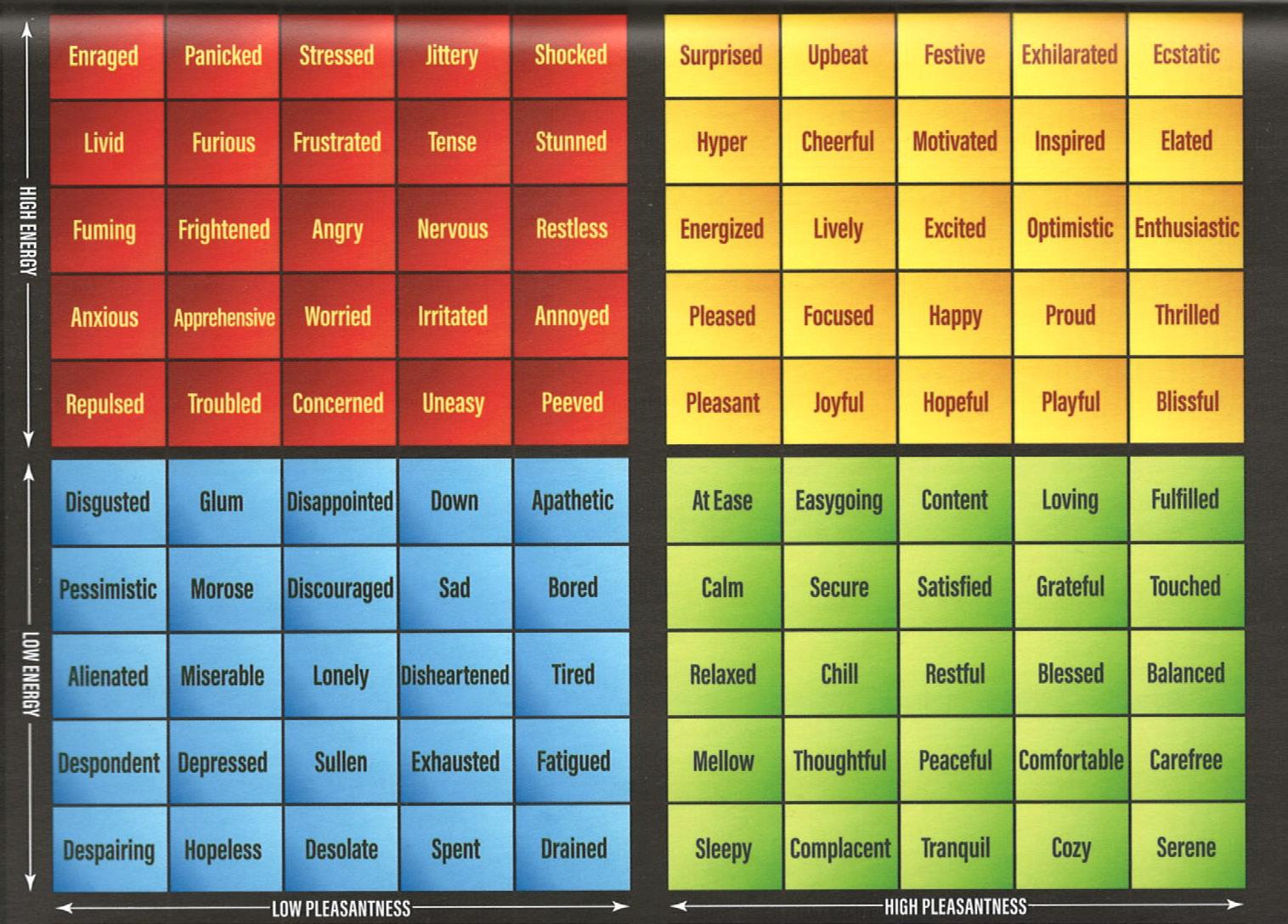
The feelings described in the left quadrants may appear uncomfortable at first glance; however, even these kinds of emotions can serve certain situations well. For example, if someone is feeling jittery or tense, that may be the ideal mindset to run a race at a track meet. If they’re feeling frustrated or troubled about an injustice, these feelings may energize them to advocate for change.
The goal of the tool is not to exist solely within the quadrants on the right side. Rather, the goal is to internalize the permission to feel, using these tools to widen one’s capacity to fully experience the spectrum of human emotion. Weiser adds, “Even in learning how to navigate emotions on the left side, humans are rewiring their brains, creating new maps and pathways toward resilience.”
Each zone can be leveraged in various ways:
Yellow zone—Ideal for brainstorming, energetic group activities, creative problem solving
Green zone—Ideal for self-reflection, consensus building, collaboration
Red zone—Ideal for writing a persuasive argument, advocating, competitive activities
Blue—Ideal for focus, critical thinking, relating with empathy
When using the tool, it is helpful to ask these questions:
• What specific word best describes your current feeling? Do you find it easy or difficult to pinpoint a word for your current feeling?
• What do you think caused you to feel this way?
• How are you expressing this feeling? Is that a helpful expression given your current situation?
• Would you like to keep feeling this emotion or shift to a new one?
• What strategy will you use to feel more, less, or the same of this emotion?
One application of this tool Windward has explored is using it to take a “temperature check” of staff members at the beginning of a meeting. It can be used anonymously or publicly and, in either case, serves the purpose of encouraging attendees to look inward, pinpoint how they are feeling, and reflect on how their emotional state may impact their approach to the discussion.
As students learn about the Mood Meter, they may see the grid in their classrooms (with or without emotion words); they will be encouraged to check in with their bodies to see which zone best represents how they’re feeling and then assign language to it. Associate Head of School Jonathan Rosenshine explains, “Over time, and with teacher support, students will expand their emotional vocabularies, growing their emotional intelligence and gaining deeper insights into themselves and others.”
Emotional granularity—the ability to precisely identify and distinguish between emotions—is a fundamental piece of achieving balance: Specificity aids in understanding, communicating, and regulating emotions. Ultimately, becoming fluent in the language of emotion can be both powerful and
IN CASE YOU MISSED IT:
Check out the episode of Pencils Down with Jamie Williamson featuring Dr. Anna Weiser.


A school library is more than just a quiet place filled with books; it’s a dynamic space where students develop essential research skills, learn to navigate technology, and build confidence in their ability to process and organize information. At Windward, the library curriculum plays a vital role in supporting the School’s commitment to student success, preparing students to become critical thinkers and proficient researchers.
An important role of the library at Windward is teaching students how to responsibly conduct research. “We don’t just show students where to find information,” explains Helen Prichett, librarian at the Manhattan campus. “We teach them how to evaluate sources, distinguish fact from misinformation, and synthesize what they learn.”
As early as fourth grade, students are introduced to library databases and begin learning basic catalog searches. By middle school, they’re completing research projects that require them to use multiple sources and evaluate credibility. A big part of this shift is the integration of technology. “This year, we’ve started working even more closely with the IT department to blend technology and research skills,” says Westchester Lower School’s Madison DiFrisco. “Students are learning not only how to find reliable information but also how to responsibly use AI and digital tools in their research.”
Melanie Murphy of Westchester Middle School agrees, adding, “We recently introduced Canva for presentations, and students are using PowerPoint’s Speaker Coach to practice public speaking. These tools bridge the gap between research and real-world application.”

At Windward, the library curriculum and Study Skills program go hand in hand. Students develop research skills in library class before they even begin Study Skills in grade 8, ensuring a smoother transition. “In seventh grade, we introduce note-taking strategies using note cards, so students are already familiar with them before they get to Study Skills,” Murphy explains.
Throughout all grades, librarians emphasize the importance of credible sources. “I tell students, ‘We use databases because they’re reviewed by experts—not just someone online,’” says DiFrisco. Developing critical thinking skills early ensures students become more independent in their research.
Beyond research and academic work, Windward’s libraries offer hidden gems, from digital resources to collaborative spaces. “We provide databases, research tools, and even professional development resources for teachers,” says DiFrisco. For students who prefer audiobooks or e-books, Windward offers Sora, an online lending library. “Listening to an audiobook is still reading,” notes Prichett. The library is also a gathering place. “We see so many kids come in during recess—not just to study,
Windward’s libraries offer hidden gems, from digital resources to collaborative spaces.

but to connect with each other,” Murphy notes. “They’ll work on puzzles, explore new topics, or simply have discussions. It’s a space that fosters community.”
Perhaps the most meaningful part of the job is helping students develop a love of reading. For younger students, read-alouds make books exciting. DiFrisco shares, “Even students who don’t consider themselves avid readers get engaged when they hear a great story.”
To encourage independent reading, librarians create displays based on student interests. “They often don’t realize there’s a whole section of books on a topic they’ve shown an interest in,” says
Murphy. Windward is also expanding its selections to make reading more accessible and engaging. She adds, “A lot of our students gravitate toward graphic novels, and we want to provide them with books that they truly enjoy.”
In addition to supporting study habits, Windward’s libraries encourage a lifelong love of learning. Whether it’s helping a student find the perfect book, guiding them through a research project, or teaching them how to evaluate information online, the library is an invaluable resource. “Our goal is to make sure students leave Windward with the skills they need to succeed—not just in high school, but in life!” says Prichett.


Westchester Middle School teacher Brianna DiStefano and her husband welcomed her first baby, a boy named Luca Alexander Collacuro, on August 3, 2024. He weighed 7lbs 4oz. Brianna shared, “Both my husband and I simply adore him!”

Manhattan Lower School teacher Katherine Lemone and her husband welcomed their first child, Sophie Lane Cunningham, on November 14, 2024. They are enjoying their time as new parents and can’t wait to see what life has in store for baby Sophie.
Megan Franco, assistant coordinator of special services at the Manhattan campus, and her husband Matias welcomed baby girl Casey Jane Franco on November 11, 2024.

Manhattan Lower School coordinator of math Samantha Downey married Patrick Downey on July 27, 2024, with Windward teachers Lauren Sosnik, Jenna Enright, and Colleen Enright in attendance.



Operations and Event Manager Lindsey McIntosh got married in November, 2024!
Westchester Lower School Teacherin-Residence Staff Developer Lisa Sheptin is completing her 20th year at Windward this year. Lisa started as an assistant teacher during the 2005-2006 school year in a secondgrade class. She taught for 10 years before also becoming a staff developer at WLS.

Lisa Sheptin, pictured left, in class photo from her first year at Windward.

Manhattan Lower School teacher Sarah Nordgren got engaged in November and will be married in Castine, Maine in August.

Jamie Simon, a grade 5 teacher at the Manhattan Lower School campus, got engaged to her high school sweetheart Jack Heitner on her birthday, December 29, 2024.
Lenny Harington is running for the Putnam County Legislature representing District 9, Mahopac, New York.
Jeffrey Lolacono works at Centric Brands Holding LLC, as human resources generalist. Jeffrey married Victoria Garufi April 29, 2022, and they celebrated the birth of their child, Luca Jeffrey LoIacono, on April 6, 2023.
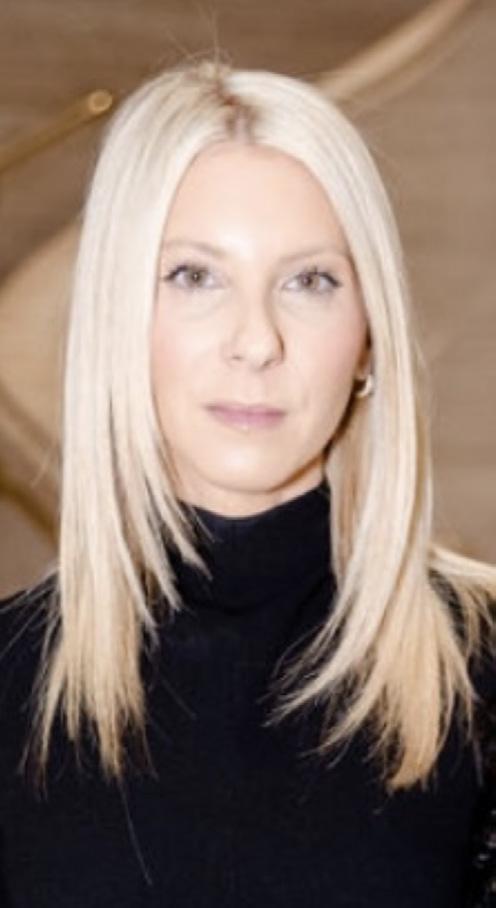
Kim Burd ’01 is a dedicated advocate for children’s health, safety, and education. Serving on the boards of Children’s Hospital of Philadelphia and Asphalt Green, a sports facility in New York City, Kim has devoted her life to serving those around her. At Asphalt Green, Kim started an adaptive sports program for children with special needs. She is receiving the Zesiger Award of Excellence at their gala this year for her work on the adaptive sports program.
The Zesiger Award honors the legacy of Al and Barrie Zesiger, the founding donors of Asphalt Green’s AquaCenter, which serves New Yorkers with life-saving swim instruction. It is also home to Asphalt Green’s elite athletes, who have competed on the world’s biggest stages. The Zesiger Award is awarded to advocates who exemplify the commitment to transforming lives through sports, fitness, and play for all.
Kim credits this love of service to her time spent as a special education teacher at a Title I school in the Lower East Side, where she saw firsthand the importance of education and advocation for underserved children. Kim is also a real estate marketing specialist and says she still uses the lessons that she learned at Windward to guide her professional and personal life: “I give Windward a lot of credit for mapping out this path for me.”

Nicholas Hertz and his wife Madeline welcomed son Theodore on January 10, 2025. His 2-yearold sibling, Claire, is so excited to have a baby brother!
Caroline Bronston-Marino married Greg Marino in 2022 at Tribeca Rooftop in New York City.
Mary Dutton married Trevor Dutton and moved to Connecticut. They welcomed their first baby, Liam Dutton, on February 14, 2024. Mary works at the Community Foundation of Middlesex County.
MaryRose Sorrento welcomed her daughter, Emelina Rose Sorrento, on April 30, 2025.
Charlie Hinnant has achieved a milestone for his startup Rave Me Away, a software company dedicated to improving communication and emergency response for attendees and staff at live events. The prototype is now live, and the application is available for download. Currently, the company is looking for beta testers, as well as summer interns for 2025. They are also affiliate members with the National Independent Venue Association and spoke on the Risk Management Panel at the Fest Forums Conference in Santa Barbara, California in February 2025.
LEARN MORE ABOUT RAVE ME AWAY:



Seth Brooks is now a captain in the United States Army. He married Michal Ambalu on December 5, 2023, and they welcomed their first child, TJ, on September 24, 2024. They live in Kew Gardens Hills.
Grace Halvey was accepted into the Duke University MBA program and will be starting classes this fall.
Grace’s dad shares, “As the application process unfolded, I could not help but remember that Grace could barely read before she went to Windward and reflect on the vital role that Windward has played in her development and success.”
Simon Brooks works for the U.S. Department of Transportation as an engineer.
Teaken Haggerty is a graphic illustrator at Be-Design Company in New York City.
Owen Tyler is a regimental academic officer for Maine Maritime Academy. Owen secured an agreement with the school to devote $20,000 for paying teachers to tutor students who were at risk of failing. Owen also meets with younger students to mentor them and point them toward resources to help them succeed in the Academy.

Juliana Rocco is majoring in psychology and criminal justice at SUNY Oneota. She was named to the Fall 2023, Spring 2024, and Fall 2024 dean’s lists.
Andrew Srulowitz is the starting goalie for the Yeshiva University hockey team.

Oscar Ceria graduated from University of Colorado Boulder in May 2024 with a degree in Art and Leadership from its School of Education. Last fall, he moved to Paris to begin a new chapter working at Hermès, as part of the creative team at their flagship store on 24 Rue du Faubourg SaintHonoré. Oscar recently reconnected with Outplacement Director Diane Kissner while she was in Paris!



*Note: At The Windward School, a student’s class year is the same as their high school graduation year.

Matt Egelberg spent two summers working at Acadia Youth Conservation Corps in Acadia National Park, helping complete projects that are vital to the park’s operation, function, and safety. Matt is returning this summer to work with Friends of Acadia, where he will be assisting visitors, hiking to collect data, repairing cairns, and interacting with park visitors.
Charlotte Green was awarded the Scholar Athlete Award by Croton Harmon High School and was awarded a scholarship for the College of the Holy Cross, where she is now a freshman.
William Handfield is a freshman at East Carolina University, where he is majoring in computer science.
Maya Hallac attends Horace Greely High School and won third place at the Somers Science Fair. Maya is also a volunteer at Development Ladder.
Lila Lovejoy received the John Forman Award, which is awarded to someone who shows exemplary leadership and citizenship. Lila volunteers at Judea Garden in Washington, Connecticut, and she also recently volunteered at a wolf sanctuary in Colorado. She is currently writing books in her free time.
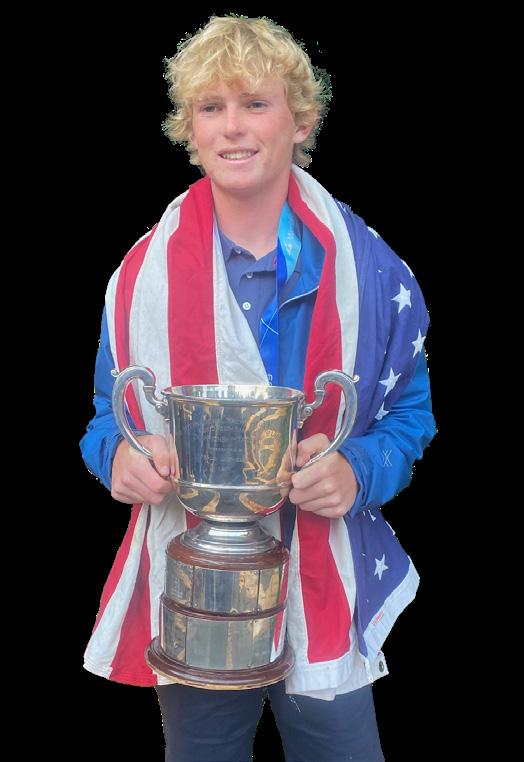

Freddie Parkin won gold at the Allianz Youth World Sailing Championships in the 420-sailboat class in 2022 in the Netherlands. He now attends Stanford University.

2026
Rohan Novelo attends the United States Performance Academy and is playing hockey this season with Westchester Express 18U AAA Premier and Apple Core EHL Junior Program. This year, Rohan was granted membership in the National Society of High School Scholars.
Jordan Birnbaum attends York Preparatory School and works as the administrator of the Lilac on Pier 25. Jordan is the organization’s alternate for the Hudson River Park Trust Advisory Council, where he represents the organization as a nonvoting member.
The Windward School received the sad news of the passing of the following individuals. The Windward community extends its condolences to the family and friends of the deceased. Please email alumni@thewindwardschool.org if you receive notice of a deceased community member for inclusion in the next issue of The Compass.
GREGORY D. KENNEDY Former trustee and alumni parent
ANN SULLIVAN Former trustee
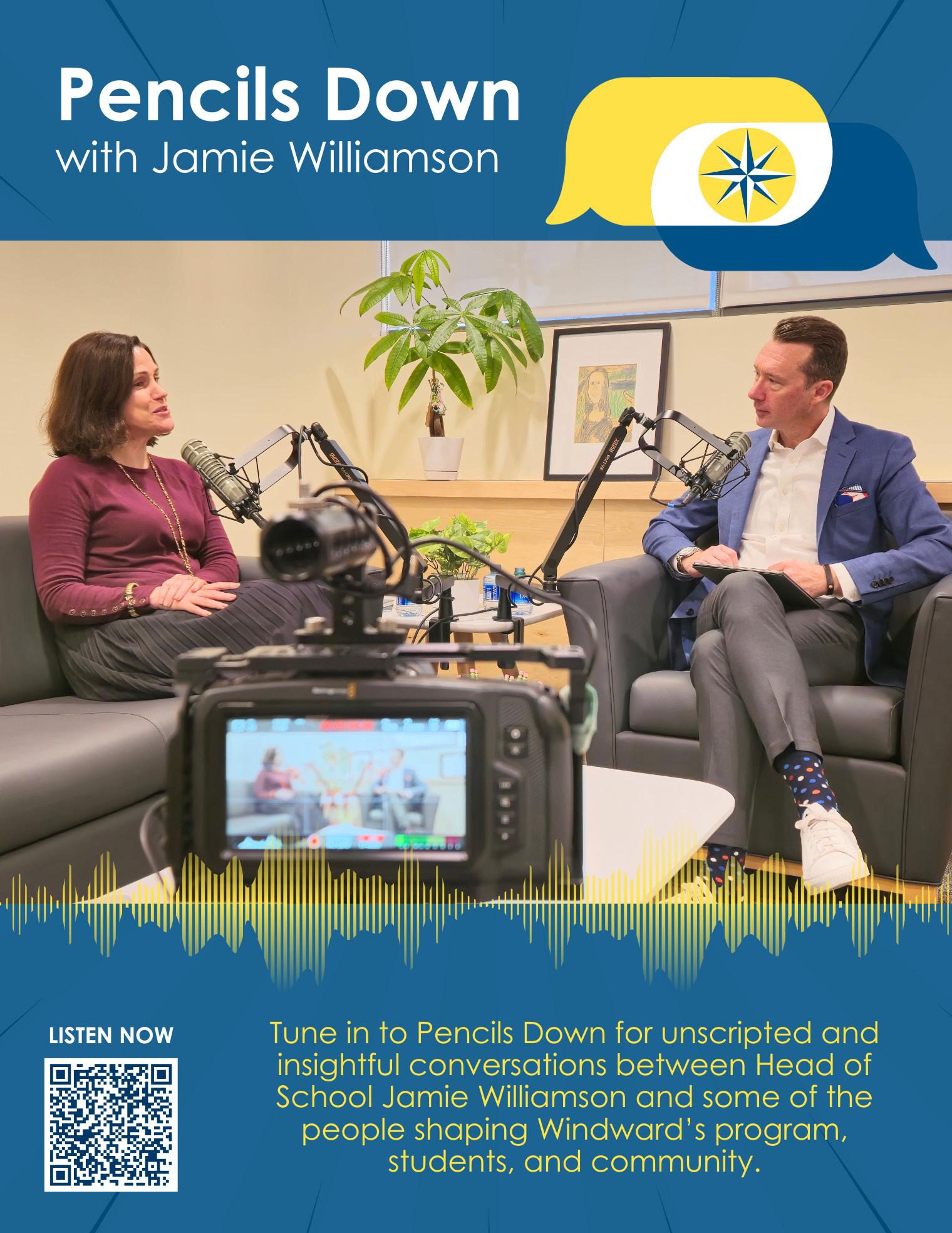


1275 Mamaroneck Avenue
White Plains, NY 10605
Return Service Requested
To be added to The Compass mailing list, please email communications@thewindwardschool.org
Explore the READ Podcast, with topics related to literacy, teaching, language-based learning disabilities, and more.
Join our frequent, informative webinars, offered to the Windward community at no cost.
Attend two free community lectures each year, featuring prominent leaders in the field of literacy.
Scan the QR code to learn more.

